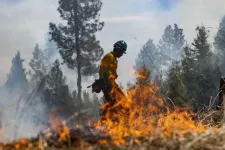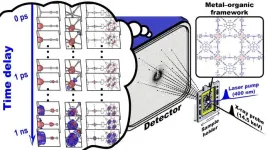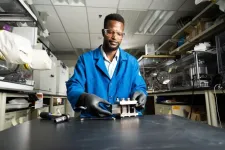(Press-News.org) MISSOULA – The escalation of extreme wildfires globally has prompted a critical examination of wildfire management strategies. A new study from the University of Montana reveals how fire suppression ensures that wildfires will burn under extreme conditions at high severity, exacerbating the impacts of climate change and fuel accumulation.
The study used computer simulations to show that attempting to suppress all wildfires results in fires burning with more severe ecological impacts, with accelerated increases in burned area beyond those expected from fuel accumulation or climate change.
“Fire suppression has unintended consequences,” said lead author Mark Kreider, a Ph.D. candidate in the forest and conservation sciences program at UM. “We’ve known for a long time that suppressing fires leads to fuel accumulation. Here, we show a separate counter-intuitive outcome.”
Though fire suppression reduces the overall area burned, it mainly eliminates low- and moderate-intensity fires. As a result, the remaining fires are biased to be more extreme, Kreider said. The new study published March 25 in Nature Communications, shows how this “suppression bias” causes average fire severity to increase substantially.
“Over a human lifespan, the modeled impacts of the suppression bias outweigh those from fuel accumulation or climate change alone,” he said. “This suggests that suppression may exert a significant and underappreciated influence on patterns of fire globally.”
Kreider led the research as part of his Ph.D. dissertation work with the support of a National Science Foundation Graduate Research Fellowship.
Fire suppression exacerbated the trends already caused by climate change and fuel accumulation, the study found, causing areas burned to increase three to five times faster over time relative to a world with no suppression.
Suppression, through preferentially removing low- and moderate-severity fire, also raised average fire severity by an amount equivalent to a century of fuel accumulation or climate change.
“By attempting to suppress all fires, we are bringing a more severe future to the present,” said Kreider.
Andrew Larson, Kreider’s Ph.D. adviser and a professor of forest ecology at UM, said this has significant impacts on ecosystems.
“Traditional suppression removes the low-severity fires that help perpetuate healthy forests by consuming fuels and preferentially killing thin-barked tree species,” Larson said. “I wonder how much we are altering natural selection with fire suppression by exposing plants and animals to relatively less low-severity fire and relatively more high-severity fire.”
However, the new findings also show that allowing more low- and moderate-intensity fire can reduce or reverse the impacts of the suppression bias. Suppression strategies that allow fire to burn under moderate weather conditions – while still suppressing fires during more dangerous fire weather – reduced average fire severity and moderated the rate of burned area increase, the team found.
“It may seem counterintuitive, but our work clearly highlights that part of addressing our nation’s fire crisis is learning how to accept more fires burning when safely possible,” said Philip Higuera, a co-author and UM professor of fire ecology. “That’s as important as fuels reduction and addressing global warming.”
Developing and implementing technologies and strategies to safely manage wildfires during moderate burning conditions is essential, Kreider said. This approach may be just as effective as other necessary interventions, like mitigating climate change and decreasing unintentional human-related ignitions.
The article, “Fire suppression makes wildfires more severe and accentuates impacts of climate change and fuel accumulation,” was co-authored by Kreider, Larson, Higuera, William Rice, and Nadia White from the University of Montana, as well as Sean Parks, an ecologist with the Aldo Leopold Wilderness Research Institute.
###
END
(Santa Barbara, Calif.) — While Hollywood and Silicon Valley love the limelight, California is an agricultural powerhouse, too. Agricultural products sold in the Golden State totaled $59 billion in 2022. But rising temperatures, declining precipitation and decades of over pumping may require drastic changes to farming. Legislation to address the problem could even see fields taken out of cultivation.
Fortunately, a study out of UC Santa Barbara suggests less extreme measures could help address California’s water issues. Researchers combined remote sensing, big data and machine ...
Humans pass on more viruses to domestic and wild animals than we catch from them, according to a major new analysis of viral genomes by UCL researchers.
For the new paper published in Nature Ecology & Evolution, the team analysed all publicly available viral genome sequences, to reconstruct where viruses have jumped from one host to infect another vertebrate species.
Most emerging and re-emerging infectious diseases are caused by viruses circulating in animals. When these viruses cross over from animals into humans, a process known as zoonosis, they can cause disease outbreaks, epidemics and pandemics such as Ebola, flu or Covid-19. Given the enormous impact ...
Understanding the behavior of matter is crucial for advancing scientific fields like biology, chemistry, and materials science. X-ray crystallography has been instrumental in this pursuit, allowing scientists to determine molecular structures with precision. In traditional X-ray crystallography experiments, a single crystal is exposed to X-rays multiple times to obtain diffraction signals. This poses a problem, where the sample has its structure altered or damaged by X-ray exposure.
In recent years, advances in technology have allowed for the development of “time-resolved serial femtosecond crystallography” (TR-SFX). In serial ...
More efficient use of phosphorus could see limited stocks of the important fertiliser last more than 500 years and boost global food production to feed growing populations.
But these benefits will only happen if countries are less wasteful with how they use phosphorus, a study published today in Nature Food shows.
Around 30-40 per cent of farm soils have over-applications of phosphorus, with European and North American countries over-applying the most.
The global population is due to hit nearly 10 billion by 2050 and it is estimated that to feed ...
RICHLAND, Wash.— A commonplace chemical used in water treatment facilities has been repurposed for large-scale energy storage in a new battery design by researchers at the Department of Energy’s Pacific Northwest National Laboratory. The design provides a pathway to a safe, economical, water-based, flow battery made with Earth-abundant materials. It provides another pathway in the quest to incorporate intermittent energy sources such as wind and solar energy into the nation’s electric grid.
The researchers report ...
Scientists from The Australian National University (ANU) have discovered a gene mutation is responsible for causing psoriasis – a chronic inflammatory skin disease that causes patients to develop red, scaly and itchy patches across their body.
According to ANU researcher Dr Chelisa Cardinez, if two copies of this mutated gene (known as IKBKB) are present, patients with psoriasis may go on to develop psoriatic arthritis, leaving them with joint pain, stiffness and swelling. Thanks to the world-first discovery from ANU, scientists now know what causes the progression from a skin-only disease to a skin and joint disease.
It’s hoped the findings will lead ...
In the United States, community health centers (CHCs) mainly serve historically marginalized populations. New research reveals that both before and during the COVID-19 pandemic, females receiving care at rural CHCs were less likely to be up to date with cervical cancer screening than those in urban CHCs. Factors associated with these differences included the proportion of patients with limited English proficiency and low income, as well as area-level unemployment and primary care physician density. The findings are ...
ANN ARBOR, Mich. – Many parents struggle deciding whether their middle or high school aged child should stay home from school if they don’t feel well, a new national poll suggests.
Among top factors: how their adolescent or teen is behaving due to symptoms and if they can get through a school day, the risk that they’re contagious and whether the student will miss a test, presentation or after school activity.
One in five parents also consider if their child needs a mental health day, according to the University of Michigan ...
Physicians in Canada, especially male physicians, are working fewer hours than they did 3 decades ago, and these long-term trends must be considered in workforce planning, according to new research in CMAJ (Canadian Medical Association Journal) https://www.cmaj.ca/lookup/doi/10.1503/cmaj.231166.
"Canadian physicians' work hours, crucial for health care access and planning, have seen a long-term decline, especially among male and married physicians, suggesting a shift towards better work–life balance," said Dr. Boris Kralj, Department of Economics, Centre for Health Economics & Policy Analysis, McMaster University, Hamilton, Ontario.
Using ...
Drugs, both legal and illegal, cause millions of cases of severe intoxication every year, leading to health complications and even fatalities. Often, they are also implicated in violent and sexual harassment crimes, as well as accidents. Obtaining detailed information about the drugs consumed by a criminal or victim is often challenging. Forensic professionals rely on drug screening techniques performed on biological samples, such as blood or saliva, to gather crucial evidence.
Today, various types of practical drug screening methods exist, each with their own unique advantages ...








